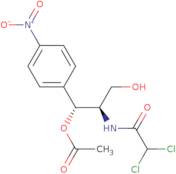Chloramphenicol 1-acetate
CAS: 23214-93-9
Ref. 3D-FC19923
| 1mg | Ausgelaufen | ||
| 2mg | Ausgelaufen | ||
| 5mg | Ausgelaufen | ||
| 10mg | Ausgelaufen | ||
| 25mg | Ausgelaufen |
Produktinformation
- N-[(1R,2R)-2-(Acetyloxy)-1-(hydroxymethyl)-2-(4-nitrophenyl)ethyl]-2,2-dichloro-acetamide1-Acetoxychloramphenicol1-Acetylchloramph enicol
- N-[(1R,2R)-2-(Acetyloxy)-1-(hydroxymethyl)-2-(4-nitrophenyl)ethyl]-2,2-dichloroacetamide
- Acetamide, N-[2-(acetyloxy)-1-(hydroxymethyl)-2-(4-nitrophenyl)ethyl]-2,2-dichloro-, [R-(R*,R*)]-
- Acetamide, N-[(1R,2R)-2-(acetyloxy)-1-(hydroxymethyl)-2-(4-nitrophenyl)ethyl]-2,2-dichloro-
- Acetamide, 2,2-dichloro-N-[β-hydroxy-α-(hydroxymethyl)-p-nitrophenethyl]-, β-acetate, D-threo-(-)-
Chloramphenicol is an antibiotic that inhibits the synthesis of proteins by binding to the 50S ribosomal subunit. It has been shown to inhibit collagenase activity in a model system and to bind to receptors on cells, thereby activating specific cellular responses. Chloramphenicol has been shown to be effective against hepatitis B virus and does not affect the growth of normal cells. However, it does inhibit the growth of human leukemia cells in vitro, which may be due to its ability to prevent transcription of messenger RNA (mRNA) by inhibiting protein synthesis. Chloramphenicol is also used as a bacteriostatic agent against Gram-positive bacteria, such as Staphylococcus aureus, Enterococcus faecalis, and Clostridium perfringens.





